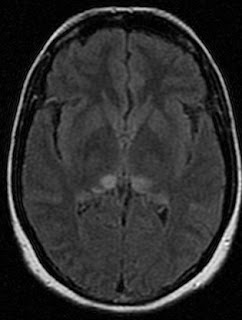

Creutzfeldt-Jakob Disease (CJD) typically causes a rapidly progressive dementia that may be associated with other neurologic features such as cerebellar or visual disturbance. New variant CJD differs; psychiatric and sensory symptoms, which are frequently painful, are prominent at presentation. Investigations, including electroencephalography and cerebrospinal fluid analysis for 14-3-3 protein, are useful as diagnostic aids but lack specificity. Presently, the diagnosis of variant CJD can be confirmed only at postmortem examination. However, there is a characteristic abnormality seen in the posterior thalamic region (the so called “pulvinar sign”) which is highly sensitive and specific for variant CJD. The pulvinar sign has been found in 90+% of pathologically proven vCJD cases. The differential diagnosis for abnormal findings in this region includes bilateral thalamic infarcts, vasculitis, perinatal ischemic insult, deposition of iron or copper, and neoplastic infiltration—particularly of lymphoma or glioma. Follow up of other results like CSF is awaited.
No comments:
Post a Comment